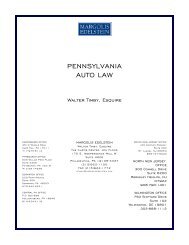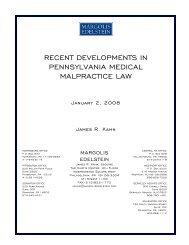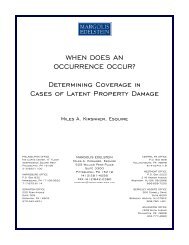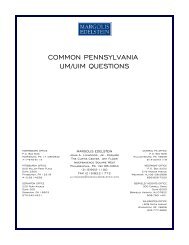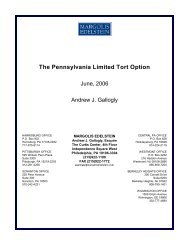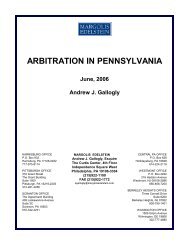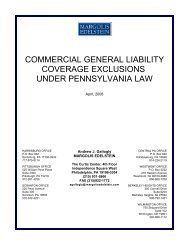selected topics in pennsylvania legal malpractice law - Margolis ...
selected topics in pennsylvania legal malpractice law - Margolis ...
selected topics in pennsylvania legal malpractice law - Margolis ...
Create successful ePaper yourself
Turn your PDF publications into a flip-book with our unique Google optimized e-Paper software.
A breach of contract claim aga<strong>in</strong>st an attorney does not require proof that an attorney failed<br />
to follow a specific <strong>in</strong>struction of the client. A pla<strong>in</strong>tiff need only demonstrate that an attorney has<br />
breached his implied contractual duty to provide <strong>legal</strong> service <strong>in</strong> a manner consistent with the<br />
profession at large. Gorski v. Smith, 812 A. 2d 683 (Pa. Super 2002).<br />
Generally speak<strong>in</strong>g, for a pla<strong>in</strong>tiff to successfully ma<strong>in</strong>ta<strong>in</strong> a cause of action for breach of<br />
contract the pla<strong>in</strong>tiff must establish 1) the existence of a contract <strong>in</strong>clud<strong>in</strong>g its essential terms, 2) a<br />
breach of a duty imposed by the contract, and 3) resultant damages. Gorski, supra. In a simple<br />
contract action there is no need to allege negligence unless the alleged breach is based on an implied<br />
contractual duty to provide professional skills consistent with those expected <strong>in</strong> a given field.<br />
McShea v. City of Philadelphia, 995 A. 2d 334 (Pa. 2010); Bailey v. Tucker, 533 Pa. 237, 621<br />
A.2d 108 (1993).<br />
A contract claim is governed by the four-year statute for contract claims, 42 Pa .C.S. § 5525,<br />
and is not be subject to a contributory negligence defense, though it might be defended by<br />
contend<strong>in</strong>g that the client’s negligent actions were <strong>in</strong> breach of the implied contract.<br />
CONTRIBUTORY NEGLIGENCE<br />
Any degree of contributory negligence is a complete bar to recovery <strong>in</strong> cases not <strong>in</strong>volv<strong>in</strong>g<br />
bodily <strong>in</strong>jury or tangible property damage. The Pennsylvania Comparative Negligence Act, 42<br />
P.S.§ 7102, applies only to actions seek<strong>in</strong>g damages for death, bodily <strong>in</strong>jury, or property damage.<br />
A <strong>legal</strong> <strong>malpractice</strong> claim is for economic loss, and thus the negligence of the client <strong>in</strong> br<strong>in</strong>g<strong>in</strong>g<br />
about the loss acts as a complete bar A purely monetary loss does not constitute damage to tangible<br />
property and, as a result, the comparative negligence statute will not apply; rather, the common <strong>law</strong><br />
doctr<strong>in</strong>e of pure contributory negligence applies. Rizzo v. Michner, 584 A.2d 973 (Pa. Super.<br />
1990). Columbia Medical Group v. Herr<strong>in</strong>g and Roll, P.C., 829 A. 2d 1184 (Pa. Super. 2003)<br />
The Superior Court has recognized contributory negligence as a complete defense to a <strong>legal</strong><br />
<strong>malpractice</strong> action sound<strong>in</strong>g <strong>in</strong> negligence. Gorski v. Smith, 812 A.2d 683 (Pa. Super. 2002). The<br />
Superior Court <strong>in</strong> Gorski noted that contributory negligence can be found where a client withholds<br />
<strong>in</strong>formation from his attorney, misrepresents to the attorney crucial facts regard<strong>in</strong>g circumstances<br />
<strong>in</strong>tegral to the representation or fails to follow the specific <strong>in</strong>structions of the attorney.<br />
“The burden of prov<strong>in</strong>g the pla<strong>in</strong>tiff guilty of contributory negligence falls squarely on the<br />
defendant.” Good v. City of Pittsburgh, 382 Pa. 255, 114 A.2d 101 (1955). It is error for a trial<br />
judge to charge a jury that the pla<strong>in</strong>tiff is obliged to show a case that is free from contributory<br />
negligence. Rice v. Shuman, 513 Pa. 204, 519 A.2d 391 (1986); Brown v. Jones, 404 Pa. 513,<br />
172 A.2d 831 (1961). While the pla<strong>in</strong>tiff does not have to affirmatively establish there was an<br />
absence of contributory negligence, if the pla<strong>in</strong>tiff reveals factors which demonstrate contributory<br />
negligence, he or she may not recover. Brown v. Jones, 404 Pa. 513, 516, 172 A.2d 831 (1961).<br />
-5-



